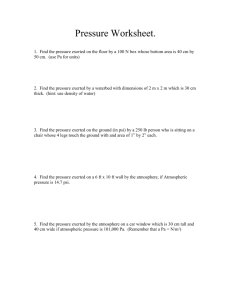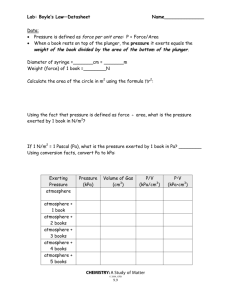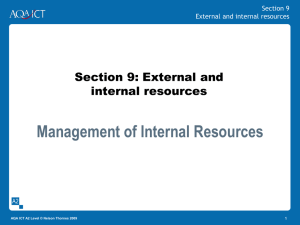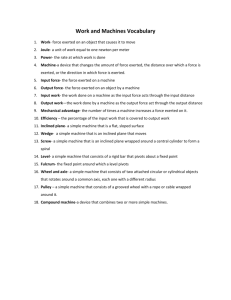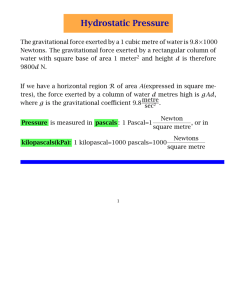PowerPoint - science
advertisement
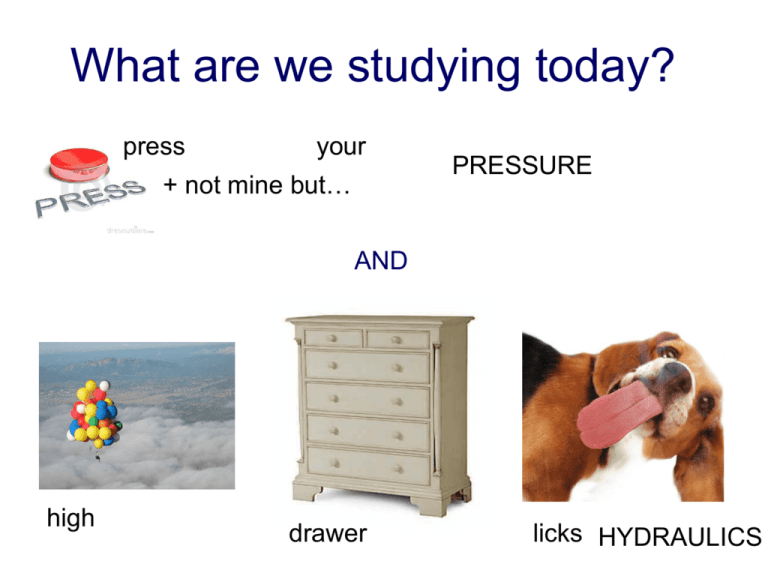
P3 1.2 What are we studying today? press your + not mine but… PRESSURE AND high drawer licks HYDRAULICS AQA Science © Nelson Thornes Ltd 2006 1 P3 1.2 http://www.youtube.com/watch ?feature=endscreen&v=qiFL_ yOvV8Y&NR=1 Siri’s feeling the pressure AQA Science © Nelson Thornes Ltd 2006 2 P3 1.2 18 March 2016 Pressure and Hydraulics Objectives Be able to describe what pressure is and how it applied to hydraulic systems. AQA Science © Nelson Thornes Ltd 2006 3 P3 1.2 Outcomes • All MUST be able to describe pressure is. • MOST Should be able to use the equation for pressure. • SOME could be able to rearrange the equation for pressure and use it in different situations. AQA Science © Nelson Thornes Ltd 2006 4 P3 1.2 Definition: • Hydraulics is the use of pressure in liquids. To understand hydraulics, first we must understand pressure. • Pressure is the Force per Unit Area. • Pressure (Pascals) = Force (N) / Area (m2) Crushing Can demo: http://www.youtube.com/watch?v=0NZmo-qQxIk P3 1.2 How a gas exerts pressure • A gas consists of molecules in constant random motion. • When a molecule collides with a surface it reverses direction due to the force exerted on it by the surface. • The molecule in turn exerts a force back on the surface. • The pressure exerted by the gas is equal to the total force exerted by the molecules on a particular area of the surface divided by the area. • pressure = force / area P3 1.2 Pressure examples pressure in Pa or N/m2 Space (vacuum) 0 Air pressure at the top of Mount Everest 30 000 Average pressure of the Earth’s atmosphere at sea level at 0°C Typical tyre pressure 101 325 Pressure 10m below the surface of the sea 200 000 Estimated pressure at the depth (3.8km) of the wreck of the Titanic 41 000 000 180 000 Other pressure units Note: You do not need to learn any of these for the GCSE exam Atmospheres (atm) Often used to measure the pressure of a gas. An atmosphere is the average pressure of the Earth’s atmosphere at sea-level at a temperature of 0°C. Standard atmospheric pressure = 101 325 Pa (about 101 kPa) Bars and millibars (bar; mbar) Also used to measure gas pressure. One bar is about the same as one atmosphere. Millibars are often found on weather charts. 1000 millibars = 1 bar = 100 kPa P3 1.2 Pounds per square inch (psi) Often used to measure car tyre pressures. 1 psi = 6895 Pa 1 atm = 101 kPa = 14.7 psi tyre pressure gauge P3 1.2 Inches of mercury (inHg) Often found on domestic barometers. 1 inHg = 3386 Pa 1 atm = 101 kPa = 29.9 inHg Examples: Fair weather – high pressure: 30.5 inHg Rain – low pressure: 29.0 inHg P3 1.2 Pressure and Hydraulics • Watch: • http://www.youtube.com/watch?v=6b3x BUxv0qE&playnext=1&list=PL1696A54 29EF5BC33&feature=results_video • Prepare to describe the 3 most important things you learn from this – you may want to jot points down in the back of your book AQA Science © Nelson Thornes Ltd 2006 10 P3 1.2 Pressure, p pressure = force area p=F A units: force, F – newtons (N) area, A – metres squared (m2) pressure, p – pascals (Pa) P3 1.2 also: force = pressure x area F and: area = force pressure p A Note: 1 Pa is the same as 1 newton per square metre (N/m2) P3 1.2 Pressure exerted by a person on a floor 1. Weigh the person in newtons. This gives the downward force, F exerted on the floor. 2. Draw, on graph paper, the outline of the person’s feet or shoes. 3. Use the graph paper outlines to calculate the area of contact, A with the floor in metres squared. (Note: 1m2 = 10 000 cm2) 4. Calculate the pressure in pascals using: p = F / A P3 1.2 Typical results 500 N 1. Weight of person: _____ 2. Outline area of both 60 feet in cm2 ____ 3. Outline area of both 0.006 feet in m2 _____ 500 N 4. Pressure = ________ 0.006 m2 83 000 Pa = _______ Why off-road vehicles have large tyres or tracks P3 1.2 In both cases the area of contact with the ground is maximised. This causes the pressure to be minimised as: pressure = vehicle weight ÷ area Lower pressure means that the vehicle does not sink into the ground. P3 1.2 Question sheet – 15 minutes • Work with your partner and complete as many questions as you can Extension on next page Pressure exerted by a block question P3- 1.2 extension The metal block, shown opposite, has a weight of 900 000N. Calculate the maximum and minimum pressures it can exert when placed on one of its surfaces. Maximum pressure occurs when the block is placed on its smallest area surface (2m x 3m) p=F/A = 900 000N / 6m2 Maximum pressure = 150 000 Pa Minimum pressure occurs when the block is placed on its largest area surface (3m x 5m) p=F/A = 900 000N / 15m2 Minimum pressure = 60 000 Pa 2 m 3 m 5 m P3 1.2 Question 1 Calculate the pressure exerted by a force of 200N when applied over an area of 4m2. p=F/A = 200N / 4m2 pressure = 50 Pa P3 1.2 Question 2 Calculate the force exerted by a gas of pressure 150 000 Pa on an object of surface area 3m2. p=F/A becomes: F=pxA = 150 000 Pa x 3 m2 force = 450 000 N P3 1.2 Question 3 Calculate the area that will experience a force of 6000N from a liquid exerting a pressure of 300kPa. p=F/A becomes: A=F/p = 6000 N ÷ 300 kPa = 6000 N ÷ 300 000 Pa area = 0.02 m2 P3 1.2 Complete: force area pressure 40 N 8 m2 5 Pa 500 N 20 20 m2 25 Pa 400 N 5 m2 80 Pa 20 N 2 cm2 100 kPa 6N 2 mm2 3 MPa P3 1.2 What can you do? • I most definitely can describe what pressure is. • I should be able to apply my understanding and use the equation for pressure. • I may be able to rearrange the equation for pressure and use it in different situations. • Tell me what you thought was easy about this lesson and what was difficult. Anything that would help you in the future? • Eg: I thought that …. was easy/difficult because … • It would help if …

